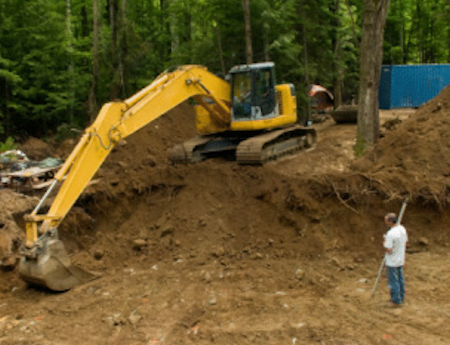The Basics
Introduction
Excavation and trenching are among the most hazardous construction operations. The Occupational Safety and Health Administration's (OSHA) Excavation standards, 29 Code of Federal Regulations (CFR) Part 1926, Subpart P, contain requirements for excavation and trenching operations. The OSHA standard applies to all open excavations made in the earth's surface, which includes trenches.
Excavations and Trenches
Excavations. OSHA defines an excavation as any man-made cut, cavity, trench, or depression in the Earth's surface formed by earth removal.
Trenches. A trench is defined as a narrow excavation (in relation to its length) made below the surface of the ground. In general, the depth of a trench is greater than its width, but the width of a trench (measured at the bottom) is not greater than 15 feet (4.6 m).
The Dangers of Trenching and Excavation Operations
Trenching and excavation work presents serious hazards to all workers involved.
- Cave-ins pose the greatest risk and are more likely than some other excavation-related incidents to result in worker fatalities. One cubic yard of soil can weigh as much as a car. An unprotected trench can be an early grave. Employers must ensure that workers enter trenches only after adequate protections are in place to address cave-in hazards.
- Other potential hazards associated with trenching work include falling loads, hazardous atmospheres, and hazards from mobile equipment.
In 2022, a 17-year-old worker suffered fatal injuries after being struck in the head by a large chunk of asphalt, and a company foreman was injured that same year when an unprotected section of excavation wall caved-in. The employees were working for a contractor on a residential sewer connection.
After an investigation, OSHA issued a serious citation and financial penalty to the contractor for its violation of federal law. Several years later, having failed to take adequate measures to protect its employees, the contractor faces over $200,000 in proposed penalties.
Trenching standards require protective systems on trenches deeper than 5 feet, and soil and other materials kept at least 2 feet from the edge of a trench. Additionally, trenches must be inspected by a knowledgeable person, be free of standing water and atmospheric hazards and have a safe means of entering and exiting prior to allowing a worker to enter.
Knowledge Check Choose the best answer for the question.
1-1. What does OSHA's excavation standard apply to?
You forgot to answer the question!

